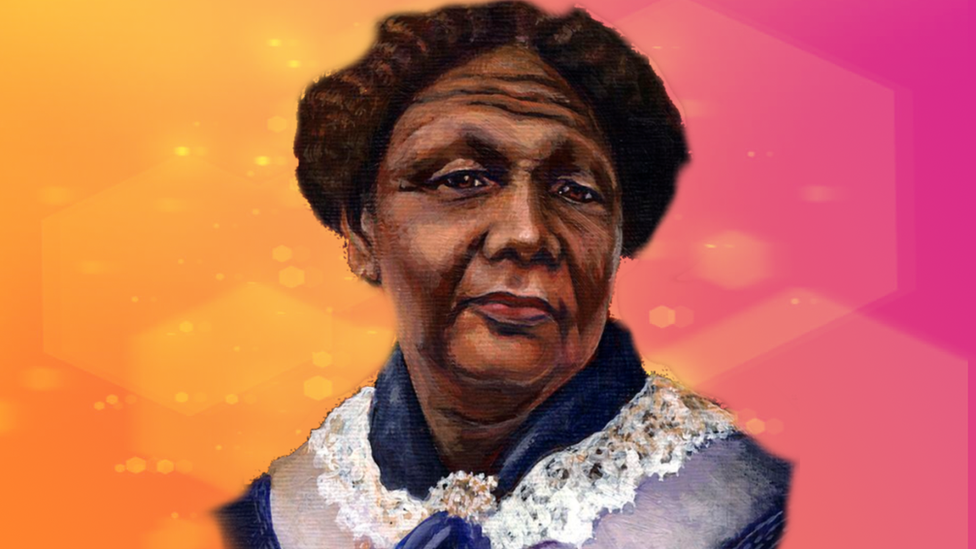Mary Seacole: Why is she a nursing hero?
- Published
- comments

A new temporary hospital named after nursing hero Mary Seacole opened in Surrey earlier this month.
The NHS Seacole Centre is dedicated to helping people recovering from the coronavirus.
Several temporary hospitals have been opened recently to support Covid-19 patients and many have been named after pioneers in the world of nursing and medicine like Florence Nightingale.
However, Mary Seacole's recognition is especially important for lots of people from black and minority ethnic (BAME) backgrounds.
So who was she and why is she remembered?
Headley Court in Surrey was recently reopened as the Seacole Centre in honour of Mary Seacole
Mary was a Jamaican-born woman who cared for British soldiers who had been injured during the Crimean War.
Her incredible efforts were not only significant at the time, but they are also a reminder of the many contributions black Britons have made to the country throughout British history.
She was born in Jamaica
Mary was born in Jamaica to a white father and black mother
Mary Jane Grant was born in Kingston Jamaica more than 200 years ago in 1805. Her mother was Jamaican and her father was Scottish.
At this time, lots of people had been forced into slavery. However, because Mary's father was white, she was born a 'free person'.
She later became Mary Seacole after she married her English husband Edwin in 1836. Sadly, Edwin fell ill and passed way just eight years later.
She learned a lot about nursing from her mother
Who was Mary Seacole?
Mary's mother ran a hotel called Blundell Hall.
It was here that she looked after lots of wounded soldiers using traditional herbal remedies which Mary picked up and developed.
She enjoyed travelling
Mary travelled to different countries in the Caribbean
Mary loved to travel, although at the time, it wasn't common for women to do so.
Before marrying her husband Edwin, she took trips to other countries in the Caribbean including Haiti, Cuba and the Bahamas. She also visited Central American and Britain.
Mary was also a business woman. She brought back different spices and food items from her travels to sell back home in Jamaica.
Mary nursed victims during the cholera outbreak
Ayshah's been finding out more about Mary Seacole.
Mary Seacole helped look after lots of Jamaican people affected by the cholera outbreak in 1850.
Cholera is a disease caused by eating food or drinking water infected with a specific type of bacteria and during the time that Mary was alive, many died from it.
Yellow fever, which is a disease that mosquitoes can carry, was also widespread at the time. Mary helped care for people suffering from this disease too.
Mary treated soldiers during the Crimean War
This image of Mary Seacole was published in Punch magazine in 1857
The Crimean War began in 1853 and ended in 1856. Britain, France, Turkey and Sardinia joined forces to fight against Russia which was attempting to take over the Danube region. This was under Turkish control at the time.
More than 200,000 soldiers lost their lives during the war. Mary wanted to join the team of nurses who went to support British soldiers, headed up by Florence Nightingale.
Her request was rejected, but this didn't phase her. She ended up funding her own trip to Crimea along with her friend Thomas Day.
Mary nursed many soldiers in Crimea and she became known as 'Mother Seacole' because of how great she was at caring for the injured., She set up the "British Hotel" which she described as "comfortable quarters for sick and convalescent officers".
Some of the soldiers she supported wrote letters to newspapers in Britain praising Mary for all the amazing things she'd done to help them.
Later life
A statue of Mary Seacole stands outside St Thomas' Hospital, London
Despite that, after the war she returned to England with little money and in ill health.
The press focussed attention on what had happened to her and, in July 1857 a benefit festival was organised to raise money for her, attracting thousands of people.
Later that year, Mary published her memoirs, 'The Wonderful Adventures of Mrs Seacole in Many Lands'.
She died on 14 May 1881.
